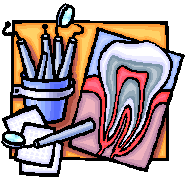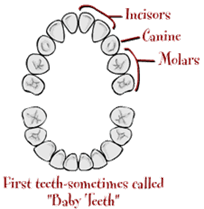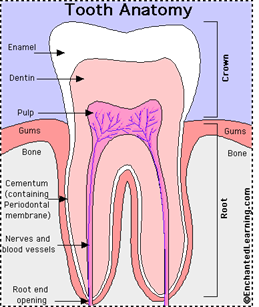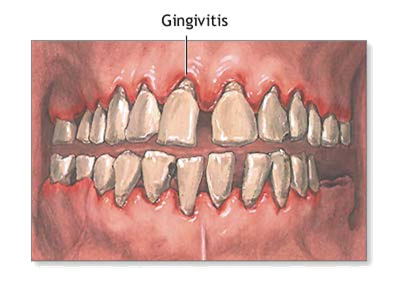
TEETH AND GUMS
Unit Overview
This unit describes the importance of proper tooth maintenance. This unit will detail the makeup of a tooth, some common problems, and how to prevent those problems.
The
Importance of Teeth
We need teeth to bite and chew food into small pieces. Teeth help give our face a beautiful smile.
Our first teeth are called baby teeth. These start to appear around six months old and start to fall out around six years old. It's important to take good care of our baby teeth because they save space for our permanent teeth.
Humans have two sets of teeth, the baby teeth (also called the primary teeth) and the permanent teeth. Children have 20 primary teeth; they are replaced by the permanent teeth by about age 13. Adults have 32 permanent teeth
 Taking Care of Your Teeth
Taking Care of Your Teeth
Here are some rules
for Teeth Care.
1.Brush your teeth every morning and every night.
2.Use a toothbrush that has soft bristles and a flat top.
3.Visit the dentist twice a year.
4.Do not eat a lot of sweets.
5.Eat fruit and dairy products everyday.
6.After eating, brush your teeth or at least rinse your mouth.
Foods
for a Healthy Smile
It is important to eat healthy foods to keep our bodies healthy and our teeth strong. Dairy products such as milk, yogurt, and cheese make our teeth stronger. Fruits and vegetables give us energy and vitamins.
Here are some healthy
eating tips:
- -snack on fruits, raw vegetables
- -drink plenty of water
- -eat breads, cereals, rice and pasta
- -limit sugary, fatty, and salty foods
- -eat dairy products at least twice a day
- -eat five fruits and vegetables a day
![]() Now answer questions 1-3.
Now answer questions 1-3.
 Tooth Glossary:
Tooth Glossary:
Cementum - a layer of tough, yellowish, bone-like tissue that covers the root of a tooth. It helps hold the tooth in the socket. The cementum contains the periodontal membrane.
Crown - the visible part of a tooth.
Dentin - the hard but porous tissue located under both the enamel and cementum of the tooth. Dentin is harder than bone.
Enamel - the tough, shiny, white outer surface of the tooth.
Gums - the soft tissue that surrounds the base of the teeth.
Nerves - nerves transmit signals (conveying messages like hot, cold, or pain) to and from the brain.
Periodontal membrane/ligament - the fleshy tissue between tooth and the tooth socket; it holds the tooth in place. The fibers of the periodontal membrane are embedded within the cementum.
Pulp - the soft center of the tooth. The pulp contains blood vessels and nerves; it nourishes the dentin.
Root - the anchor of a tooth that extends into the jawbone. The number of roots ranges from one to three.
![]() Now answer questions 4-6.
Now answer questions 4-6.
Malocclusion
Occlusion refers to the alignment of teeth and the way that
the upper and lower teeth fit together (bite). Ideally, all upper teeth fit
slightly over the lower teeth. The points of the molars fit the grooves of the
opposing molar. All teeth are aligned, straight, and spaced proportionally. The
upper teeth keep the cheeks and lips from being bitten and the lower teeth
protect the tongue.
Malocclusion is the most common reason for referral to an orthodontist. Very
few people have perfect occlusion. However, most occlusion abnormalities are so
minor that they do not require treatment. By treating moderate or severe
malocclusion, the teeth are easier to clean and there is less risk of tooth decay and periodontal diseases (gingivitis or periodontitis).
Treatment eliminates strain on the teeth, jaws and muscles, which lessens the
risk of breaking a tooth and reduces symptoms of temporomandibular joint
disorders.

Gingivitis is an inflammation of the gums caused by plaque and bacteria accumulation.
Malocclusion is most often hereditary. There may be a disproportion between the
size of the upper and lower jaws or between jaw and tooth size resulting in
overcrowding of teeth or in abnormal bite patterns. Extra teeth, malformed
teeth, impacted or lost teeth, and teeth that erupt in an abnormal direction
may contribute to malocclusion. Variations in size or malformation of either
jaw may affect its shape, as can birth defects such as cleft lip and
palate.
During infancy, personal habits like thumb sucking, tongue thrusting, pacifier
use beyond the age of three, and prolonged use of a bottle can greatly affect
the shape of the jaws as well. The improper fit of dental fillings, crowns,
appliances, retainers or braces may contribute to malocclusion. Misalignment of
jaw fractures after a severe injury, and tumors of the mouth or jaw may cause
malocclusion as well.
Type 1 malocclusion is the most common. It occurs when the bite is normal but teeth are crowded or malpositioned.
Type 2 malocclusion, called retrognathism or overbite, occurs when the upper jaw and teeth overlaps the bottom jaw and teeth.
Type 3 malocclusion, called prognathism or underbite, occurs when the lower jaw protrudes forward and the lower teeth extend over the upper teeth.
![]() Now answer questions 7-11.
Now answer questions 7-11.
Cavities
Your mouth is a busy place. Bacteria - tiny colonies of living organisms are constantly on the move on your teeth, gums, lips and tongue. Having bacteria in your mouth is a normal thing. While some of the bacteria can be harmful, most are not and some are even helpful. Certain types of bacteria, however, can attach themselves to hard surfaces like the enamel that covers your teeth. If they're not removed, they multiply and grow in number until a colony forms. More bacteria of different types attach to the colony already growing on the tooth enamel. Proteins that are present in your saliva (spit) also mix in and the bacteria colony becomes a whitish film on the tooth. This film is called plaque, and it's what causes cavities.
![]() Now
answer questions 12-13.
Now
answer questions 12-13.
Prevention
of Cavities
Fluoride is a natural element that can be found in many things, like the water we drink and the food we eat. Decades ago, scientists began to notice that children who lived in places where fluoride occurred naturally in the water, had fewer dental cavities.
Fluoride that is absorbed by your body is used by the cells that build your teeth to make stronger enamel. Topical fluoride - fluoride that is applied to the outside of the enamel - makes the crystals that form enamel more durable. Tooth enamel crystals that have fluoride are much more resistant to acid. They are less likely to breakdown and cause the tooth surface to become porous.
If your dentist recommends a fluoride treatment during your next dental visit, you'll be receiving topical protection. The fluoride your dentist puts in your mouth will help make the crystals in your tooth enamel stronger. Always use a toothpaste with fluoride. Look for the Canadian Dental Association seal of approval on the toothpaste tube in your bathroom.
![]() Now answer question 14.
Now answer question 14.
Gingivitis
Gingivitis is the inflammation of the gums around the teeth due to improper cleaning of teeth. Although systemic factors and general health can modify the tissue reaction to local irritants, Gingivitis in all age groups is caused primarily by local irritants. It is nearly always reversible. The usual signs of gingivitis are gums which are swollen and bleed on brushing.
Gingivitis
Treatment
The goal is to reduce the gingival inflammation. The teeth are cleaned thoroughly by the dentist or dental hygienist. This may involve various instruments or devices to loosen and remove deposits from the teeth (scaling).
Meticulous oral hygiene is necessary after professional tooth cleaning. The dentist or hygienist will demonstrate brushing and flossing techniques. Professional tooth cleaning in addition to brushing and flossing may be recommended twice per year or more frequently for severe cases. Antibacterial mouth rinses or other aids may be recommended in addition to frequent, careful, tooth brushing and flossing.
![]() Now
answer questions 15-17.
Now
answer questions 15-17.
Periodontitis
Periodontitis is an advanced stage of gum (periodontal) disease that can result in the loss of your teeth. Some form of gum disease affects about 80 percent of American adults.
The cause of gum disease is bacteria, which can also cause tartar buildup. Together, these conditions irritate your gums and lead to bleeding. The early stage of gum disease is called gingivitis. Left unchecked, gingivitis can progress to the more serious periodontitis. Untreated, periodontitis will progress until your teeth loosen and fall out.
Thorough daily brushing, regular flossing and frequent professional cleaning reduce your chances of developing serious gum disease
![]() Now
answer questions 18-19.
Now
answer questions 18-19.

Below are additional educational resources and activities for this unit.
Unit 9 Teeth and Gum Cloze Key